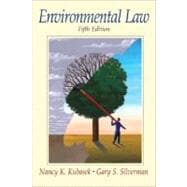
Note: Supplemental materials are not guaranteed with Rental or Used book purchases.
Purchase Benefits
What is included with this book?
| An Introduction To The Law | |
| The American Legal System: The Source of Environmental Law | |
| Sources of Law | |
| Classifications of Law | |
| Constitutional Principals Underlying the American Legal System | |
| The Litigation Process and Other Tools for Resolving Environmental Disputes | |
| The Adversary System | |
| The U.S. Dual Court System | |
| Primary Actors in the Legal System | |
| Steps in Civil Litigation | |
| Alternatives to Civil Litigation | |
| Administrative Law and Its Impact on the Environment | |
| Creation of Administrative Agencies | |
| Functions of Administrative Agencies | |
| Limitations on Agency Powers | |
| Important Agencies Affecting the Environment | |
| The Environmental Laws | |
| An Introduction to Environmental Law and Policy | |
| The Need for Regulation | |
| Alternative Ways to Control Pollution | |
| Evolution of Our Environmental Policy | |
| National Environmental Policy Act. Pollution Prevention Act of 1990 | |
| Air Quality Control | |
| The Major Air Pollutants | |
| Some Significant Air Quality Problems | |
| The Initial Approach to Air Quality Control | |
| The Current Approach to Air Quality Control | |
| The 1990 Clean Air Act Amendments | |
| Solutions Beyond the Clean Air Act | |
| Water Quality Control | |
| The Major Water Pollutants | |
| Some Significant Water Quality Problems | |
| Radon and Other Radionucleotides | |
| Protecting Water Through Government Actions | |
| Controlling Toxic Substances | |
| Identification of Potentially Toxic Substances | |
| Federal Regulation of Toxic Substances | |
| International Regulation of Toxic Substances | |
| Toxic Torts | |
| Waste Management and Hazardous Releases | |
| Waste Control Techniques | |
| The Problem with Waste | |
| Requirements for Managing Waste | |
| CERCLA: An Overview | |
| Emergency Response Plans and Right to Know | |
| Federal Response to Contaminated Sites | |
| Underground Storage Tank Program | |
| Energy | |
| Energy Policy: A Historical Overview | |
| Energy Consumption and Production | |
| Coal: The Oldest Energy Source | |
| Petroleum and Natural Gas | |
| Nuclear Energy | |
| Renewable Fuels | |
| Natural Resources | |
| Protecting Public Lands | |
| Wetlands, Estuaries, and Coastal Areas | |
| Protection of the Great Lakes | |
| Wild and Scenic Rivers Program | |
| Endangered Species | |
| International Environmental Law | |
| The Need for International Environmental Law | |
| The Nature of International Law | |
| Sources of International Environmental Law. | |
| Institutions That Effectuate and Influence International Environmental Law | |
| Addressing Specific International Environmental Problems | |
| The Future of International Environmental Law | |
| Environmentalism and Trade | |
| Table of Contents provided by Publisher. All Rights Reserved. |
The New copy of this book will include any supplemental materials advertised. Please check the title of the book to determine if it should include any access cards, study guides, lab manuals, CDs, etc.
The Used, Rental and eBook copies of this book are not guaranteed to include any supplemental materials. Typically, only the book itself is included. This is true even if the title states it includes any access cards, study guides, lab manuals, CDs, etc.